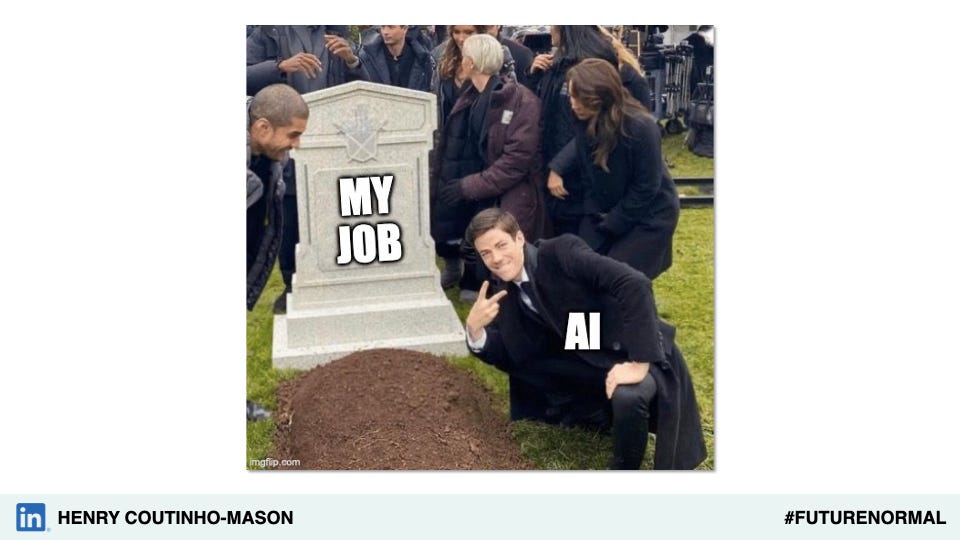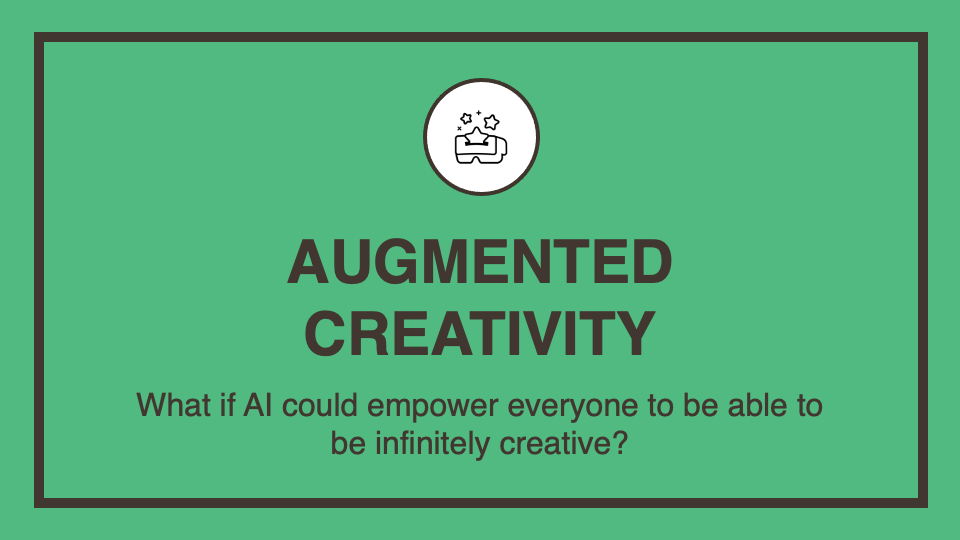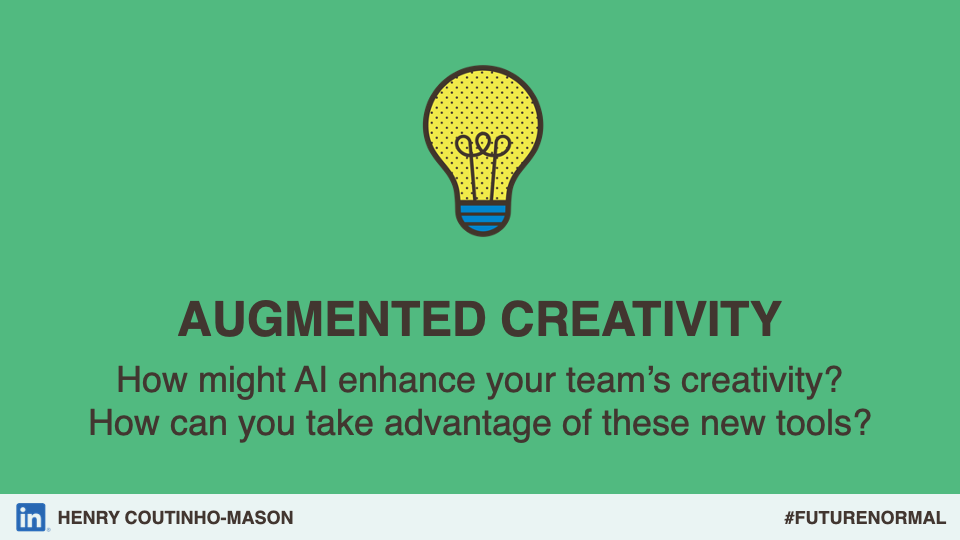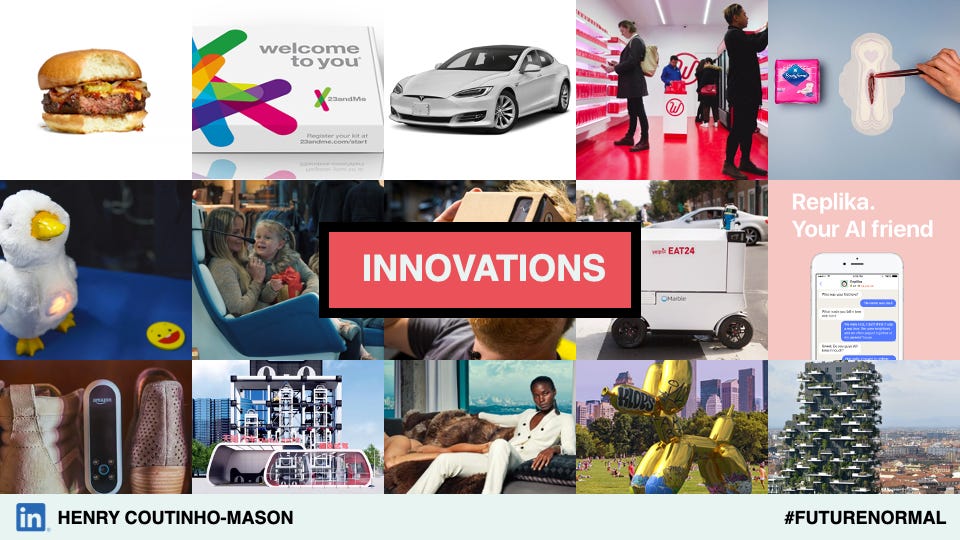Building a Future-Proofed AI Strategy
An executive's guide to navigating rapid change.
This week I’m sharing a version of a presentation on AI that I’ve given half a dozen times over the past few months, to various leadership teams spanning healthcare, financial services, retail, media and real estate businesses. The innovation case studies change each time, depending on the audience (and as newer examples are released!). But the underlying framework stays the same. I hope you find it useful.
tl;dr: Every executive is being asked ‘what’s your AI strategy?’ The big challenge here is that no one knows where AI is headed (not even the people creating it!).
So you need a way to think about AI that is (1) durable – i.e. will remain relevant for the next few years; (2) flexible – i.e. can accommodate the inevitable new developments; (3) actionable – i.e. that empowers your frontline teams to anticipate change; and (4) consistent – i.e. ensures that your teams have a shared vision and language about where and why they are applying AI.
Fortunately, I’ve spent the last 15 years thinking about how to do this. While running TrendWatching, one of the world’s leading trend firms, I built a methodology which helps over 1,000 of the world’s biggest brands to understand, anticipate and act on emerging trends (if you want to geek out on this, you can find it all in my first book Trend-Driven Innovation).
At its heart, it involves asking three questions:
What are the basic human needs that my organisation serves?
How are today’s innovations changing people’s expectations around those basic human needs?
How will we respond to these new and emerging expectations?
That’s it! Like the best frameworks, it’s disarmingly simple. Almost laughably so. But it works.
Now let’s apply this in the context of building a generative AI strategy that’s focused on people and their needs.
No one needs reminding of why we’re talking about AI today.
ChatGPT was released last November, and instantly became the fastest growing app in history. 1 million users in the first 5 days; 100 million in just 2 months.
But while many of you will have seen that graphic, and it seems impressive, in the grand scheme of things, 100 million people globally is still small. Over 5 billion people are now online!
So I’m actually more excited by this graph, which shows global Google Search volumes for the past 3 years for:
ChatGPT vs Metaverse vs Crypto vs Football
The yellow line is crypto. It had a brief moment in May 2021 when it looked like it was breaking through – reaching 60% of football's search volume. However it quickly fell back and since then has been in steady decline.
The flat red line along the is the metaverse – it truly never saw any mainstream interest at all.
The blue line is ChatGPT.
Incredibly, in March 2023, it surpassed 'football' in global search volumes, and indeed it has remained so for the last 3 months.
Does this mean it is destined to succeed, and crypto and the metaverse are forever dead? No, of course not.
But it's a pretty astonishing signal of just how mainstream ChatGPT has become, how quickly.
So AI is now profoundly mainstream. But the other fascinating dimension to this seemingly-overnight phenomenon is that we’ve known this is coming for a long time!
Back in 2015, Wait But Why, a widely read ‘popular’ science and technology blog (ie. non-technical – if you’re not familiar with it, Tim Urban, the writer behind it famously uses MS Paint stick person doodles to illustrate complex topics), wrote a mammoth 2-part deep dive into what he called “not just an important topic, but by far THE most important topic for our future.” In 2015!
In his article, The Artificial Intelligence Revolution, he featured this graphic showing the experience of Exponential Growth.
“You see very little progress for a long time, and suddenly you’re finished.”
And that’s the moment that we’re just entering. After between 20 and 70 years of work on AI, depending on how you count, we’ve suddenly gone from AI being one of many important topics to the topic, in less than 12 months.
You feel this every time you open your inbox or head onto a social platform, there’s an endless stream of new AI products for every conceivable use case you can imagine. There are now even dedicated search engines for AI applications (which use AI, of course!).
This exponential acceleration can feels deeply dislocating. This was captured perfectly by this tweet from that well-known futurist, Chrissy Teigen:
“I thought the Pope’s puffer jacket was real and didn’t give it a second thought. No way am I surviving the future of technology.”
And it’s easy to laugh, but I’d bet many of you can empathise with this sentiment.
And what’s curious about AI is that you’re not alone.
On the one hand, there are many technologists who think that this moment is what we’ve been waiting for. That AI, if handled correctly, could transform the world for the better.
Bill Gates wrote a public letter laying out how he hoped it could boost productivity and radically improve health and education for billions of people around the world.
Yet fairly uniquely, even some of the leading players in the industry are also flagging the potential risks of AI.
Sam Altman of Open AI, Demis Hassabis the CEO, Google DeepMind, and Geoffrey Hinton, the neural networks pioneer often called the Godfather of modern AI were among hundreds who signed this rather ominous statement:
“Mitigating the risk of extinction from AI should be a global priority alongside other societal-scale risks such as pandemics and nuclear war.”
That’s not just kind of terrifying for humanity, but on the professional level everyone here is operating on, it will leave you like this – gasping for air.
WTF. Not What the Fu*k, but What’s the Future?
How can you prepare for a future that is so uncertain? This is where I can help. This is why you’re listening to a talk on AI from someone who’s not an AI guy.
I have probably got a similar level of technical knowledge about AI as most of you – in fact, there will be people in this room who know more about the underlying technologies at play here!
But what I have spent nearly 15 years focused on is change. Specifically, thinking about how leaders of organizations like yourself can better understand rapid change.
Because change is everywhere – not just technological change, but social, political, economic and environmental changes too.
As I laid out in my first book, Trend-Driven Innovation – there is a way of looking at the world and processing what you see which ensures that, instead of being overwhelmed by relentless and accelerating change, you develop a mindset that gives you to a clear way to anticipate and seize the opportunities that AI (or any other big driver of change) presents to you.
And at the heart of this methodology is an idea that was powerfully captured by Jeff Bezos, who observed:
“I very frequently get the question: ‘What’s going to change in the next 10 years?’ … I almost never get the question—‘What’s not going to change in the next 10 years?’—And I submit to you that that second question is actually the more important of the two.”
"The answer to that question can allow you to work on those things with the confidence to know all of the energy you put into it today will still be paying dividends,"
Furthermore, he said, it's an easy question to answer.
"You don't have to do a lot of research," he said. "These things are so big and so fundamental -- you know it.”
For Amazon, the obvious answer is that customers will always want low prices, fast shipping and a large selection. Bezos says it's impossible to imagine someone saying, "'Jeff, I love Amazon, I just wish you delivered a little more slowly."
Bezos continued, "When you identify those big ideas that are stable in time... they're usually customer needs."
We saw this so powerfully in the pandemic. The world was turned upside down and we all headed on Zoom because we craved human connection.
And coming out of the pandemic – the search for status and identity, the desire for entertainment and experiences have all come roaring back.
Having clarity over the basic human needs, want and desires that your business caters to is the secret to crafting a long-term strategy that will remain relevant.
But while some things remain stable, we started this session talking about change. We are living through a moment of extreme, exponential, change. We have new tools that give us magical superpowers that we didn’t have before.
And so this brings us to the final part of understanding how to spot trends, and anticipate the future: innovations.
Specifically, if you look at the new innovations that customers are lavishing love and attention on today through the lens of the basic human needs and wants of your customers, then you will be able to draw powerful insights about what those customers will need and want in the near future.
The reason why looking at innovations is so powerful is because we live in an Expectation Economy.
What does this mean? It means that customer expectations around a basic human need or want – think the convenience and low prices mentioned by Bezos – are set by their experiences.
And because we live in a transparent world, even if you don’t or can’t personally experience the ‘best’, you are increasingly aware of it. This means that everyone’s expectations will be set by the best in class. Amazon’s ever-faster delivery times become the standard that everyone else must compete against.
This happens across the board. Apple’s design, Spotify’s choice and personalization, Airbnb’s reimagining of the travel experience around a sense of community. And of course, in AI, ChatGPT’s magical quality and accessibility.
The other big factor to think about, is that in the Expectation Economy, your customers’ expectations aren’t neatly confined to your industry. Instead, they are typically set by ‘competitors’ from outside your industry. As a bank, you’re not just competing against other banks, but against anyone on this slide who caters to the same basic human needs as you.
This is why I’m qualified to be standing here with you today, talking about AI. As I said before – I’m not an ‘AI guy’. Instead, I’ve spent a decade looking at innovation; and identifying the innovations which despite their nascent, often fringe positioning, signify the start of something bigger: a shift in people’s expectations.
I’ve spent the last 3 years exploring where the Expectation Economy is headed, working with Rohit Bhargava (author of the Non-Obvious Trend Series), on a new book, The Future Normal, which we launched at SXSW in the US a few months ago.
The book identifies 30 emerging trends, each one centred around a particular ‘instigator’ who is setting and raising expectations in a respective area; we open each chapter with a ‘what if…?’ question that explores the implications around these raised expectations.
Because, as you can guess even just from the title, we’re not simply interested in predicting the future, but the future normal. Too often, people conflate ‘futurism’ with ‘technology’. That’s why we explain in the introduction that we are ‘reluctant futurists’.
When you are thinking about AI, you shouldn’t just be interested in where the technology is headed.
The organisations who win in the Age of AI won’t do so just because they have better tech. They’ll win because they use AI to serve people better. They’ll make better products and deliver a better customer experience. As Rohit likes to observe: “people who understand people always win”.
That’s what we will focus on in this presentation. We won’t speculate too much about where AI might head – that’s a fool’s errand.
Instead, we’ll explore a simple framework that’s deeply focused on people and gives you a clear framework to think about how you can use AI in the months and years ahead.
And as you think about this framework, you should be constantly asking these two questions:
What are the basic human needs that I serve?
How can AI change how I serve them?
Steve Jobs was the master at transforming ‘tech’ into products that people wanted. Famously, he said that ”computers are like a bicycle for the mind”.
So I asked ChatGPT, if a computer is like a bicycle for the mind, then what is AI?
And one of the answers it suggested was ‘a jetpack’. And the more I thought about this, the more profound I thought the analogy was.
Because there are two reasons to use a jetpack…
On one hand, they are all about acceleration. Convenience. Efficiency.
Getting from A to B exponentially faster.
But on the other hand, people will also strap on a jetpack just to have fun! To defy gravity and soar high into the sky. To enjoy the view.
Being creative and expressing ourselves. These are important human needs too.
So when it comes to ‘what’s your AI strategy?’, it will be useful to think about where and why are you deploying AI on this spectrum:
At one end you have full automation. Removing humans from the process. Perfect convenience. Extreme efficiency.
In the middle, there will be countless situations where AI copilots will help humans do more of what they are already doing, just faster.
And then at the other end of the spectrum, AI will also profoundly change the things that people can do, personally and professionally. AI will empower hundreds of millions of people to do things that previously only specialists were able to do. And like spreadsheets two decades ago, this democratisation will profoundly change the world of work and the way in which organisations operate.
What if AI could instantly and autonomously do the repetitive or boring parts of your work & life?
OpenAI: plugins as tools for action
Most people here will have used ChatGPT.
But if you pay for it, then one of the big additional features is access to plugins – which enables it to browse the web and perform actions with / on 3rd party platforms, as you can see in this demo.
Now, while this demo looks very impressive, achieving such a seamless UX is rare, and indeed Sam Altman has admitted to developers in a closed session that they haven’t really cracked the plugin experience (yet!).
But you can see where this is headed…because the obvious next step is that if an AI can ‘read’ from multiple external sources, in real-time, could it not also ‘write’ to them?
AutoGPT: the first steps towards AGI?
That’s why the developer community was losing their minds a few months ago at the prospect of general-purpose autonomous agents like AgentGPT that, when given a goal, can break it down into its constituent parts and perform whatever actions it needs to to complete the objective.
Currently, these are more hypothetical than useful. Typically, the agents get distracted on tiny tasks and aren’t able to course-correct if they stuck on a particular task. But as we saw at the start of this session, we are on an exponential curve so it is not hard to imagine these challenges being overcome in the near future.
Cupidbot.ai: automated dating dystopia?
And while general-purpose autonomous agents might not be practical yet, there have been some interesting examples of automatous agents being applied to much more bounded tasks.
Now I'll bet that this example will invoke some strong reactions – I suspect many of you will instinctively recoil at the thought of it. However it’s also the slide that more people take a photo of than any other!
Allegedly created by a team of ex-Tinder engineers, Cupidbot.ai promises to “swipe and chat for you on dating apps so you can skip to the good part…filtering out the attention seekers and only notify you when you get a date.”
The app can run on sites such as Tinder, Bumble, and Hinge – learning from your past swiping behaviour to attempt with profiles you will like; users can select from 100+ chat tones (including funny, teasing or poetic); calendar integration means that it can schedule dates directly into a user’s calendar.
The site claims to have gotten its beta users over 50,000 numbers and dates in the first two days of their beta, and currently costs US$15 USD per month.
Do I think this is a future normal that I want for my daughter? No!
But do I hope that there are people out there who see this and get inspired to launch something more palatable? Yes! As always, this is about spotting the underlying expectation, and using it to think about how you could meet this in a different context.
Do Not Pay: automating your way through bureaucracy!
Now let’s look at a glimpse of a different kind of autonomous agent that we can all get behind – an agent that can help you negotiate your taxes!
Do Not Pay is a startup using automation to help consumers save money (contesting parking tickets, navigating bureaucracy, etc).
Its Consumer Rights Phone Assistant, released in May 2023 is an automated chatbot that will call up the IRS, navigate the phone tree option menu, and then call the user when it reaches a human customer service agent.
Let’s have more of this automation please!
There are many implications worth considering here:
Which repetitive or boring parts of your workflows (internal or external) could be done instantly and autonomously by AI?
Will you redesign your UX to be ‘bot-readable’?
Could you build new services that automate parts of the customer journey?
What monitoring systems will you have to put in place – both in terms of autonomous agents’ performance but also their ethical & legal compliance?
One thing we haven’t discussed yet is job losses, which might seem strange given it feels like whenever we hear about automation – it’s wrapped up in a conversation about job losses.
Two examples that show why I’m skeptical that widespread unemployment is just around the corner:
(1) Agriculture. Before the Industrial Revolution, more people worked in agriculture than any other sector. Now, countries like the US or Germany, the agricultural sector represents less than 2% of the workforce … [continued]
(2) Finance. Look what happened in the financial sector after the release of spreadsheet software…almost immediately demand for bookkeepers started to reverse. But what happened?
Those jobs were more than replaced by a growing number of management analysts, financial managers, accountants and auditors.
In other words – better tools didn’t replace humans. They expanded the size of the industry and actually led to better paying jobs.
if the early signals continue, we are likely to see a similar impact in how we use AI. Far from replacing humans, we will use AI to help us do tasks faster and better.
Github Copilot: making coding faster
One of the first instances of this was GitHub’s Copilot, a tool that helps programmers write code faster. It can suggest code snippets, complete functions, and even write whole programs based on natural language prompts.
To give you a sense of how much this has transformed the industry, and how rapidly the tool is improving, Github reported that in mid-2022 the tool wrote 27% of developers’ code. By February 2023, that had jumped to 46%.
Github Copilot: also making developers happier?
Github also released a study on the impact of using Copilot which showed that using the tool made people both more likely to successfully complete a task and do so faster – by a huge 55% margin.
The same study also found:
Between 60–75% of users reported they feel more fulfilled with their job, feel less frustrated when coding, and are able to focus on more satisfying work when using GitHub Copilot. Th
Developers reported that GitHub Copilot helped them stay in the flow (73%) and preserve mental effort during repetitive tasks (87%).
In other words – AI can make workers faster, better and happier!
Microsoft Office 365: the AI gorilla
And this won’t be limited to just programmers. Microsoft, as you’re probably aware of, is all in on AI.
Word, Excel, Powerpoint, Teams – are all getting the copilot treatment. What does this mean?
Here are some example prompts offered by Microsoft:
Draft a two-page project proposal based on the data from [a document] and [a spreadsheet].
Model how a change to the growth rate for [variable] would impact my gross margin.
Create a five-slide presentation based on a Word document and include relevant stock photos.
Summarize the emails I missed while I was out last week. Flag any important items.
Summarize what I missed in the meeting. What points have been made so far? Where do we disagree on this topic?
& of course, so are Google Docs, Sheets, Slides etc. In fact there isn’t a SaaS product out there which isn’t adding an AI layer to its products – Zoom, Notion, Vimeo, Canva to name just a few.
Nabla: AI copilots for doctors
It’s easy to imagine almost every job will have specialist copilots.
For example, Nabla, a digital health startup, has launched its Copilot, a service that uses GPT-3 to help doctors with their paperwork. Copilot transcribes and repurposes information from video or in-person consultations into different documents, such as prescriptions, follow-up letters, and summaries, saving doctors time and relieving them from administrative tasks.
Interestingly, Nabla’s copilot isn’t focused on offering patient diagnosis (a much more controversial and higher-risk area), and clinicians still have to review and confirm its output. Its goal is to assist and accelerate, not automate.
BloombergGPT: AI copilots for bankers
Finance is another domain where we are likely to see specialist models. For example, Bloomberg recently announced it was launching BloombergGPT, a “large language model (LLM) has been specifically trained on a wide range of financial data to support a diverse set of natural language processing (NLP) tasks within the financial industry.”
As well as performance, security will be a key driver in the B2B sector behind the emergence of private, customized LLMs.
What if your team had an army of AI assistants to help them? What would they do faster? What would they do better?
We’ve looked at how AI will enable you to automate a huge range of increasingly complex tasks, and then at how it will assist humans to do more of what they’re already doing, faster.
Finally, I want to end by exploring how AI will empower people to do new things – that they simply weren’t able to do previously (or very few people could do, or that were prohibitively expensive to do).
While increasing your team’s efficiency is likely to be your short-term focus and where the most immediate gains will be found, augmenting people’s creativity will have less obvious but more profound longer-term implications.
Colorado State Fair: AI art controversy
Let’s briefly recap some key moments in this journey. This digital artwork was, arguably, one of the moments that kicked off the debate around art, AI and creativity…
Called “Théâtre D’opéra Spatial”, it was created by game designer Jason Allen with the AI image generator Midjourney. He acknowledged Midjourney in his submission to the emerging artist division's "digital arts / digitally-manipulated photography" category at the Colorado State Fair Fine Arts Competition, but at the time of the competition in August 2022 the judges didn’t fully understand what this meant.
When the artwork was awarded first prize, it went viral on Twitter, with many artists expressing outrage that an AI-generated image could win an art competition.
Sony World Photography Awards: the controversy spreads…
Fast forward 9 months, and the world of photography was facing similar issues. German artist Boris Eldagsen deliberately entered an AI-generated image into the Sony World Photography Awards without disclosing it.
When his image won the creative open category he refused the prize, saying he used the picture to test the competition and to create a discussion about the future of photography.
What does it mean when everyone can be an artist?
Adobe Firefly: Generative AI comes to Photoshop
But while artists might want to maintain the ‘purity’ of their fields, these creative tools are both increasingly powerful and accessible. Just watch this video from Adobe to see how easy it will become to create and manipulate imagery.
Right now, these tools still sit within Photoshop, which is aimed at professional designers. But already they are being quickly adapted and deployed in even more mainstream applications.
Of course, making it easy to create and manipulate images comes with huge risks. We started the session with the Pope’s puffer jacket. That’s fairly harmless – but it’s easy to imagine these tools being used for far more problematic purposes.
We are in a Brave New World – that is awash in misinformation, and you will not be able to trust anything you see or watch, unless it has been verified by reputable sources.
MissJourney: correcting generative AI’s bias
The other huge issue with these tools today? They can produce deeply biased outputs (because they reflect their training data). For example, if you ask AI to generate images of professionals (engineers, CEOs , etc), less than 20% of the images are female.
MissJourney.ai is a creative project which launched at TEDxWomen in Amsterdam which corrects this by only outputting women characters. Right now, this is more of a stunt to highlight the issues with relying on AI tools to create the dominant media we consume.
But it hints at a broader and yet critically important question – in a world of infinite media (& media creators) how will we avoid the issues around biased or hateful outputs that plague social media?
The other takeaway here – are there opportunities for you in tackling both of these issues? Could you create or partner with a MissJourney equivalent?
Carvana: personalised marketing at scale
Without downplaying these issues and risks, here’s a more light-hearted look at the future of content in an AI world.
Carvana, the used car marketplace created 1.3 million personalised videos for its customers, based on the date, location, cultural touchpoints around the purchase, and the vehicle they bought.
These videos are still relatively basic. But you can imagine how giving anyone the ability to create dynamic, rich content will offer countless possibilities.
I’ve previously explored 25+ of these early creative generative AI use cases, across 10 different industries from media to travel to fashion.
How might AI enhance your team’s creativity? How can you take advantage of these new tools?
These examples are clearly just the tip of the iceberg. As we saw at the start of this session, there are 1,000s of new AI tools and services being launched each week.
But when you are thinking about experimenting and deploying AI, I hope this framework will be useful.
At one end of the spectrum you have full automation. In the middle, AI copilots can help humans do more, just faster. And then at the other end of the spectrum, AI will also profoundly change the things that people can do, personally and professionally.
But as well as this specific way of thinking about how and where you might use AI, I also hope I’ve given you a new way to see the world.
A way of seeing the world that allows you to turn the sense of overwhelm that you feel when looking at the sheer volume of new innovations being launched…
…and instead use those innovations as your secret weapon. Because these innovations are the tool that will help you anticipate the future.
Look for the innovations that are raising people’s expectations around the basic human needs & wants that your business caters to.
Because as Jeff Bezos said, it’s the things that don’t change – those basic human needs and wants – that should be the foundation of your strategy.
AI is just a technology. People should be what you focus on first. Get clear on why people care you exist.
Then you can ask, “how will AI help me deliver on these basic needs faster, cheaper, or better?”
What Is The Future Normal For Your Business?
My new book, The Future Normal: How We Will Live, Work & Thrive In The Next Decade, explores 30 trends, from continuous glucose monitoring to job sharing.
I also give inspiring, actionable presentations that help your team spot and seize emerging opportunities. Clients like them:
“Henry's approach was radically simple but highly practical - instead of being overwhelmed by the pace of change, you leave with a clear way to identify and seize the opportunities AI will present in the months ahead.”
Get in touch if you'd like to discuss an upcoming event or project.
Or, sit back and enjoy the keynote that myself & Rohit Bhargava gave at SXSW to launch the book:
Thanks for reading,














































Brillant 🙌